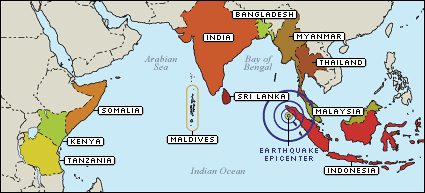Tsunami Factfile

The Indian Ocean tsunami that occured in December 2004 was the deadliest in history
by Borgna Brunner
 Before and after satellite images of Banda Aceh, North Sumatra, Indonesia. |
Related Links |
Indian Ocean Tsunami: The Deadliest in History
On Dec. 26, 2004, a 9.0 magnitude earthquake—the largest earthquake in 40 years—ruptured in the Indian Ocean, off the northwest coast of the Indonesian island of Sumatra. The earthquake triggered the deadliest tsunami in world history, so powerful that the waves caused loss of life on the coast of Africa and were even detected on the East Coast of the United States. More than 225,000 people have died from the disaster, a half a million have been injured, thousands still remain missing, and millions were left homeless.
Eleven countries bordering the Indian Ocean—all relatively poor and vulnerable—suffered devastation. Hardest hit were Indonesia (particularly the province of Aceh), Sri Lanka, India, Thailand, and the Maldives. The catastrophic damage included the destruction of entire cities, the contamination of farmland and forests, and the depletion of fishing stocks. Some areas faced starvation and increased suseptibility to disease. Even countries with relatively low death tolls suffered enormous damage—the Maldives, for example, had less than 100 deaths, yet the tsunami left 14 of the archipelago's islands uninhabitable, requiring its inhabitants to be permanently evacuated, and another 79 islands without safe drinking water.
See statistics on Deadliest Tsunamis and Deadliest Earthquakes.
The Science of Tsunami
A tsunami (pronounced soo-NAHM-ee) is a series of huge waves that occur as the result of a violent underwater disturbance, such as an earthquake or volcanic eruption. The waves travel in all directions from the epicenter of the disturbance. The waves may travel in the open sea as fast as 450 miles per hour. As they travel in the open ocean, tsunami waves are generally not particularly large—hence the difficulty in detecting the approach of a tsunami. But as these powerful waves approach shallow waters along the coast, their velocity is slowed and they consequently grow to a great height before smashing into the shore. They can grow as high as 100 feet; the Indian Ocean tsunami generated waves reaching 30 feet.
Tsunami is the Japanese word for "harbor wave." They are sometimes mistakenly referred to as tidal waves, but tsunamis have nothing to do with the tides. Tsunamis have been relatively rare in the Indian Ocean, and are most common in the Pacific Ocean.
For more details on Tsunami, see our encyclopedia article and Tsunami FAQs.
Countries Damaged by the Indian Ocean Tsunami

| Fatalities1 | Year | Magnitude | Principal areas |
|---|---|---|---|
| 350,000 | 2004 | 9.0 | Indian Ocean |
| 100,000+ | 1410 b.c. | Crete-Santorini, Ancient Greece | |
| 100,000 | 1755 | 8.5 | Portugal, Morocco, Ireland, and the United Kingdom |
| 100,000 | 1908 | Messina, Italy | |
| 40,000 | 1782 | 7.0 | South China Sea, Taiwan |
| 36,500 | 1883 | Krakatau, Indonesia | |
| 30,000 | 1707 | 8.4 | Tokaido-Nankaido, Japan |
| 26,360 | 1896 | 7.6 | Sanriku, Japan |
| 25,674 | 1868 | 8.5 | Northern Chile |
| 15,030 | 1792 | 6.4 | Kyushu Island, Japan | Source: National Geophysical Data Center, National Oceanic and Atmospheric Administration. |
| Fatalities | Year | Magnitude | Principal areas |
|---|---|---|---|
| 830,000 | 1556 | 8.0 | Shansi, China |
| 255,000+ | 1976 | 8.0 | Tangshan, China |
| 230,000+ | 2004 | 9.1 | off west coast of northern Sumatra |
| 230,000 | 1138 | n.a. | Aleppo, Syria |
| 222,570 | 2010 | 7.0 | Haiti |
| 200,000 | 1920 | 8.6 | Gansu, China |
| 200,000 | 1927 | 7.9 | near Xining, China |
| 200,000 | 856 | n.a. | Damghan, Iran |
| 150,000 | 893 | n.a. | Ardabil, Iran |
| 143,000 | 1923 | 7.9 | Kwanto, Japan |
Source: National Earthquake Information Center, U.S. Geological Survey. Data compiled from several sources. | |||







